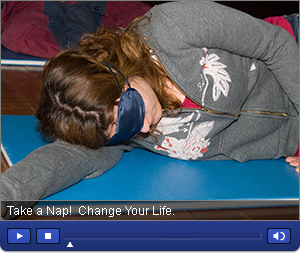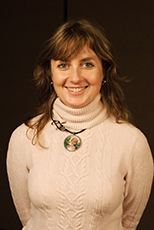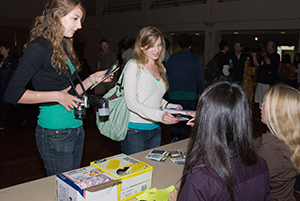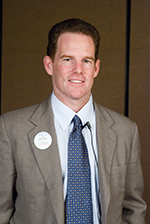Take A Nap! Change Your Life
UCSD sleep expert and author helps organize campus 'nap-in'
Ioana Patringenaru | March 16, 2009
Next time you feel tired and sleepy during the day and want to buy some coffee, think again. UC San Diego sleep scientist Sara Mednick says you would be better off taking a nap instead.

Watch a video about UCSD sleep scientist Sara Mednick's research on taking naps.
Mednick has spent several years documenting the benefits of a mid-day shut-eye. She found that napping for an hour is better than drinking a small cup of coffee. Napping also improves memory and might even boost creativity.
Last week, Mednick and university officials organized a nap-in at the Price Center Ballroom on National Napping Day, which takes place every year the day after the start of Daylight Saving Time.
“I think that we need to have a little more of a take-back the nap attitude,” Mednick told the audience in the ballroom. “So that’s what I’m here to do today.”
She went on to explain that after the time change, the number of heart attacks, car crashes and suicides increases. To make matters worse, about 40 percent of Americans sleep less than seven hours a night instead of the recommended eight hours. Two-thirds of women report having trouble sleeping more than three nights a week. “We are a sleep-deprived nation,” Mednick said.

UCSD researcher Sara Mednick gave a talk about the benefits of napping on campus last week.
Lack of sleep in turn leads to an increased risk of heart disease, high blood pressure, diabetes, depression and obesity. To cope, most of us reach for a cup of coffee, Mednick said. But her research shows that might not be the best remedy.
In one of her studies, Mednick focused on napping and memory. She divided her subjects into those that napped and those that didn’t. The latter group received either
200 mg of caffeine or a placebo. Researchers then tested the subjects on several tasks, such as typing and remembering a list of words, to gauge their visual, verbal and motor memory. Nappers performed better than those who took caffeine on all the tasks. “Of course, that’s bad news for Starbucks,” Mednick said.
“Which would you rather be: wired or smart?” she asked later.
However, not all naps are created equal. If your brain only goes through slow-wave sleep, your memory won’t deteriorate, but it won’t improve either. If you experience both slow-wave and rapid-eye movement sleep, your memory will improve dramatically, Mednick said. People who take a nap and get a good night’s sleep have the ability to learn twice as much as those who just get a night’s rest, the researcher said. “That nap is really something special,” she added. She outlines many of her findings in her book “Take a Nap! Change Your Life.”

After Mednick's talk, students picked up napping kits, which included a sleep mask and a map of the best napping spots on campus.
Mednick argues that napping is critical for college students, who need their memory to stay sharp. Last week’s nap-in is part of an initiative designed to promote a healthy learning environment on campus called Live Well UC San Diego, said Jerry Phelps, acting director of the university’s Wellness Center. The initiative includes events, such as the nap-in, and an upcoming emotional wellness discussion. Students also have access to Live Well meals at campus restaurants.
“Napping is actually an incredibly effective way of restoring sleep,” Phelps said. “It's going to make our students healthier; it's going to create happier students and more cognitively effective students.”
Mednick herself practices what she preaches and naps three times a week. She wasn’t a napper when she started doing research on the subject. But in grad school, as she saw more and more data about the benefits of napping, she decided to try it herself. “And I felt great,” she said.

Jerry Phelps, acting director of UCSD's Wellness Center, said napping can contribute to students' health.
Not everyone should nap at the same time of the day, Mednick pointed out. Teenagers and young adults have a somewhat shifted sleep cycle, going to bed late and waking up late. Their ideal napping time is in the afternoon, around 4 p.m. By contrast, the ideal nap for adults, who usually go to sleep between 11 p.m. and midnight and wake up between 6 a.m. and 8 a.m., is sometime between 1 to 3 p.m., Mednick said.
After last week’s nap-in, Michelle Peltz, a laboratory assistant in the psychology department, said she would try to nap regularly. “I think it's definitely encouraged me to start napping,” she said. “I realize the importance of it for memory and just overall performance. I think it's a great idea.”
Student Khrysten Taylor took a step further and actually dozed off on one of the mats laid out on the floor of the Price Center Ballroom. She had brought a colorful pillow with her. “I’m more focused, definitely,” she told a TV reporter after she woke up.

|